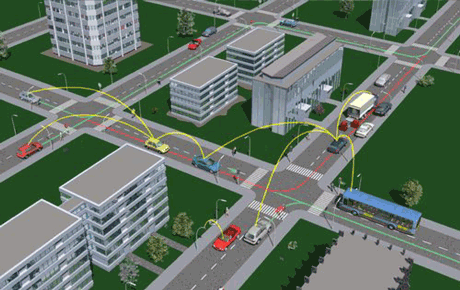by Zdeněk Lokaj, Tomas Zelinka and Miroslav Šrotýř
Cooperative systems are playing an increasingly important role in the automotive industry, particularly in relation to improvement of safety. Telecommunication solutions are crucial in cooperative systems, owing to the need to deliver data to appropriate places at appropriate times. This paper describes state-of-the-art of cooperative systems and describes one real application which is under development.
Many research and development projects are in progress around the world with the goal of developing new cooperative applications and testing them in real environments. Generally the approach of R&D in cooperative systems focuses on the following applications:
- Mitigation of risk of accidents at high speed – Electronic emergency brake lights, front collision warning systems, blind spot warnings / warnings during lane changing, overtaking warnings, left turn assistant
- Mitigation of risk of accidents at low speed – Crossroads motion assistant
- Safety awareness – Remote diagnostics (battery monitoring), stationary vehicle (or pedestrian) warnings, road conditions warnings
- Emergency applications – eCall
- Eco-Green Mobility / Vehicle Speed – Electronic payments (eg Electronic Fee Collections – EFC), traffic data collection, dedicated eco-lane, green wave, traffic signal timing for optimal stopping of the vehicle
- Applications for driver convenience – Electric-vehicle charging stations guides, eCommerce, internet access, multimedia files download, video telephony.
Telecommunication Solutions for Cooperative Systems
Since the fundamental component of cooperative systems is wireless telecommunication systems much of the research focuses on this area. Since 2009 there has been dedicated telco technology DSRC 5.9 GHz for ITS solutions communication in Europe, but studies have also been investigating the potential to use other technologies, such as WiFi (IEEE 802.11 e/n/p), mobile data services (EDGE, HSDPA, LTE, LTE-A), WiMAX (IEEE 802.16 e/m), Bluetooth (IEEE 802.15.1) and MBWA (IEEE 802.20) to analyse properties of these technologies and try to link them to the performance requirements of the cooperative applications.
Intelligent Truck Parking Application
One example of a cooperative system is the Intelligent Truck Parking Application (ITP), an R&D project currently under development at the Czech Technical University in Prague. This project is funded by the Technology Agency of the Czech Republic (project number TA02031411).
The goal of the system is to predict occupation of truck parking places on highways and immediately inform drivers via C2X telco technologies to help them plan their rest stops in accordance with legislation (eg a regular stop after eight hours of driving). This system mitigates risk by reducing the chance of a driver being unable to find an unoccupied parking space and thus having to drive to the next rest area. Based on actual information about parking occupation the driver can plan the best place to park and rest.

The Intelligent Truck Parking System uses on-line traffic data from the Czech tolling system which is the main data source for the statistical model developed to predict truck parking lot availability. To achieve greater predictive accuracy historical data from the tolling system is incorporated with actual data from traffic sensors (eg loops, video-sensors, parking entrance detectors).
The tolling system in the Czech Republic covers more than 1,365 km of highways and motorways and provides traffic data about vehicles above 3.5 t almost in real-time (with a maximum delay of approximately five minutes) so the data provides a complete description of truck traffic flow on highways including abnormalities in the flow of traffic and the source of the abnormalities.
Achievement of a reliable and highly accurate Intelligent Truck Parking system is highly dependent on a number of crucial factors:
- The availability of top quality and reliable data sources describing traffic flow as the basis for a statistical model to predict parking lot availability.
- The availability of reliable information regarding available truck parking lots in an appropriate area.
- The transmission of information via different communication channels eg VMS (Variable Message Sign), Smart Phones, RDS-TMC (Radio Data System – Traffic Message Channel) or C2C (Car-to-Car) systems.
- Implemented ITS systems need to be supported and become an integrated part of the ITS architecture.
- The statistical prediction model development for the Intelligent Truck Parking application is almost finished. The model has been constructed using historical data from the tolling system and data from transport surveys of selected highway parking places. The next step is to validate outputs of the model and calibrate it to improve its accuracy.
References:
[1] T. Zelinka, Z. Lokaj, M. Svitek: “Specific telecommunications solutions for ITS applications, Circuits, Systems, Signal and Telecommunications Conference”, in proc. Applied mathematics in electrical and computer engineering, Cambridge, Harvard, USA, MA, 2012, p. 315-322, ISBN 978-1-61804-064-0.
[2] Z. Kocur et al: “Analysis of Influence of Disturbance Level on Data Transmission in Wireless Networks”, in TSP 2010 –
33rd International conference on Telecommunications and Signal Processing [CD-ROM], Budapest: Asszisztencia Szervező Kft., 2010, p. 292-296. ISBN 978-963-88981-0-4.
Please contact:
Zdeněk Lokaj
Czech Technical University in Prague, Faculty of Transportation Sciences, Prague, Czech Republic
Tel: +420 224359611
E-mail:











